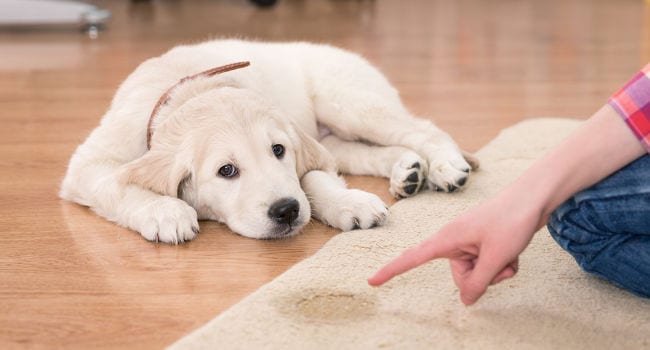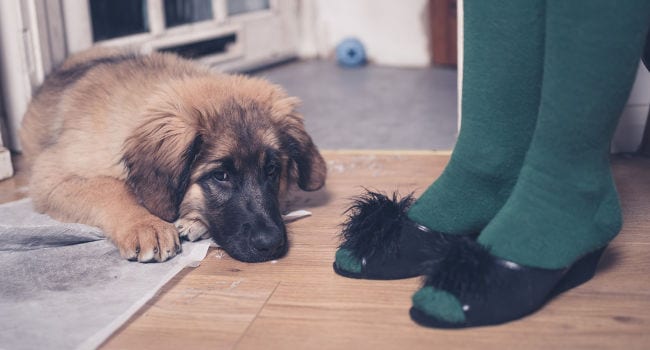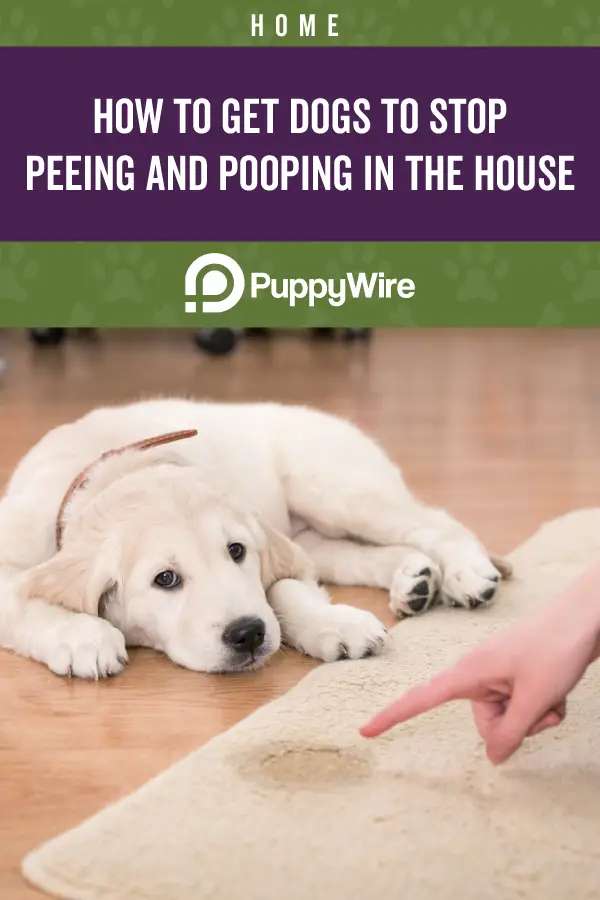How to Get Dogs to Stop Peeing and Pooping in the House

No matter your dog’s breed or age, if you have on that routinely goes to the bathroom in the house, you know what a vicious cycle it can be to keep your carpet and floors clean. You may start to wonder how to get dogs to stop peeing in the house, and this can be overwhelming if it’s never happened before.
If this sounds like you, this post is for you because we’re going to cover possible reasons why your dog may do this. We’re also going to talk about steps you can take to stop this from happening so you can try them with your own dog to see which one works best for your situation.
Four Reasons Why You Dog May Pee in the House
There are arguably dozens of reasons why our dog may pee in the house, but we’re going to cover the four biggest reasons people have found that cause this unwanted behavior.
Your Dog Suffers from Anxiety
When you leave your dogs along for longer periods of time, they can develop separation anxiety that can make them pee when they’re alone. If your dog gets distressed when you leave, the full bout of anxiety usually develops around 30 minutes after you leave, and it can last until you get back.
Other behaviors that typically go along with the anxiousness is barking, pacing, destructive chewing, or attempting to escape the house. If they do this when you’re home and they’re still in your presence, they’re most likely don’t have separation anxiety.
Your Young Dog Isn’t Fully Housebroken
If you have a young dog, or if your dog is new to the home, they may not be fully housebroken, and this can lead to accidents when you leave them alone for any period of time. They may also not have had time to develop control over their bladder, and they simply can’t hold it for hours at a time without having an accident. As a general rule, your dog should be able to hold their urine for one hour per year, with a maximum time of eight hours.
Of course, younger puppies and senior dogs may have to go to the bathroom more frequently, and you should consider this when you’re trying to figure out why your dog keeps going to the bathroom in your home. If you think time is an issue, you may want to consider keeping them in a place with hard floors to reduce the damage they do when they go to the bathroom.
Your Dog is Older or Sick
Older dogs, especially spayed females, are prone to developing urinary tract infections when they get older, and there are also other things that could be wrong if your dog starts going to the bathroom in the house suddenly. It’s a good idea to check with your vet because they can tell whether or not your dog has a UTI.
Another possible reason your dog starts to go to the bathroom in the house is simply because they’re getting older. They can start to have trouble holding their bladder just like people can, and this can lead to issues with them going to the bathroom indoors if you leave them alone for longer periods. This is also a good time to think about getting an indoor dog potty to help as well. Feel free to check out PuppyWire’s top picks here.
Territorial Marking
You’ll most likely have to deal with your dog marking their territory at some point during their lives, and this is typical behavior that can be frustrating when it first starts to happen. If you’ve recently brought new animals into the home, this could cause your dog to start marking their territory.
Additionally, your dog is more prone to continue to mark an area after they’ve already marked it. Getting your male dog neutered is one way to curb or stop territorial marking, and you can also soak the areas with an enzymatic cleaner to destroy the lingering scent.
Seven Ways to Stop Your Dog From Going to the Bathroom Indoors

There are several ways that you can do to try and stop your dog from going to the bathroom indoors. You may have to try a few of them before you find the ones that work for your dog.
1. Set up a Routine
If you’re home with your dog during the day, try to set up a routine to take them outdoors to go to the bathroom every few hours and praise them when they go. Giving your dog a lot of positive reinforcement is key to getting them to understand why going to the bathroom isn’t a good idea, and they’ll also start to associate going outside with rewards.
You do want to give your dog phrase or a treat within seconds of them going to the bathroom outside, so they start associating that with the positive reinforcement from you. Make sure that you keep your positive reinforcement sayings short because your dog will be able to tell by your tone that you’re happy with them.
2. Watch Your Dogs for Clues
Your dog will most likely start to display clues that they have to go potty before they actually do it, and you can catch them before they go to the bathroom by simply watching them. You may notice that your dog is sniffing around the area where they usually go to the bathroom, circling, or even squatting or picking up their leg to pee.
If they do, immediately ask them if they want to go outside, take them outside and wait a few minutes for them to go. Once your dog goes to the bathroom, praise them and use positive reinforcement to enforce that this is what you want them to do instead of going to the bathroom in the house.
3. Catch Your Dog Going to the Bathroom Inside
If you catch your dog going to the bathroom, make a noise or clap your hands to startle them and get them to stop going to the bathroom temporarily. Immediately take your dog outside and let them finish going to the bathroom and heap praise on when they do.
Although you might be frustrated with having to clean up a mess, it doesn’t do any good to get frustrated with your dog at this stage and spank them or rub their nose in their mess. This will only serve to make them afraid of going to the bathroom by you, and they can get nervous and go more inside.
4. Use Crating
If your dog is nervous, they may like to have a warm and safe space to go where they feel secure, and a crate is an excellent way to give them this space. As long as you have the correct size crate for your dog, you can crate them while they’re alone and they most likely won’t go to the bathroom because they don’t like to mess in their areas.
5. Hire a Dog Walker
A dog walker can solve a few problems all in one go, and they only need to stop by once a day to benefit your dog. Your dog walker will be able to take your dog out to go to the bathroom when they drop by, and a good walk can also tire your dog out, and they won’t spend as much time fretting and pacing.
6. Doggy Day Care
Doggy daycare centers are popular with both old and young dog owners, and it gets your dog out of the house while you’re gone during the day. Your dog will be able to play and socialize during the day, and you won’t have to worry about them having accidents on your carpet.
7. Use Belly Bands if All Else Fails
After you take your dog to the vet and they rule out anything that may be medically wrong with your dog, and you’ve tried over avenues, you can get belly bands for your dog. This should be a last resort, you want to remove it from your dog as soon as you get home, and be aware that these can cause rashes or UTIs if you keep it on constantly.
Deterring Your Dog from Repeat Bathroom Visits to the Same Area
Once your dog picks an area to go to the bathroom in, they’ll most likely return to the same area again and again because the scent sinks into the carpet or flooring. One easy way to deter this behavior is to buy or make a spray and lightly spritz your carpet, furniture, or floor with them on a routine basis.
- Enzymatic Sprays – You can purchase enzymatic sprays that are specially designed to get rid of pet mess odors and stains. They’re specially formulated with enzymes that break of the enzymes in your dog’s waste, and this helps to lift the stains out of your carpets.
- Lemon Juice – Dogs don’t usually like strong citrus scents, so mixing equal parts lemon juice and equal parts water in a spray bottle and spraying the area where your dog goes to the bathroom can deter them from going there again.
- Rubbing Alcohol – Rubbing alcohol’s strong smell doesn’t agree with dogs so you can make a spray using one cup of water and one cup of rubbing alcohol. Spray this around the area where your dog goes to the bathroom to get rid of the smell, and it’ll get rid of any bacteria as well.
- White Vinegar – Equal parts white vinegar and equal parts water sprayed over the area where your dog goes to the bathroom is an excellent deterrent. Dogs don’t like this smell either, and it also has neutralizing properties that will get rid of any odors from previous times your dog went to the bathroom.
How to Clean Dog Waste from Your Home
Even if you’re still trying to train your dog to go to the bathroom outside, you’ll want to clean up their accidents, so they don’t start to smell or encourage your dog to return there.
Tips for Cleaning New or Wet Spots:
- Clean up the area as soon as you see or feel it because this will give the enzymes less time to sink into your flooring and stain or cause lingering odors.
- Get paper towels, newspaper, or cloth towels and lay it over the wet area to pull the moisture up and out. Don’t rub, blot, or scrub at the area until the moisture is gone.
- To finish, blot the spot with cool water and let most of the water soak up into a clean cloth, paper towel, or newspaper. Let it air dry and repeat if you see a stain.
- Don’t use hot water to clean up the stains because this will release the ammonia in the dog urine and it’ll have a strong smell. Use cool water instead.
Tips for Cleaning Old or Dried Spots:
- Get a mixture of equal parts vinegar and baking soda and gently blot at the spot, and leave it overnight if you can. In the morning, apply cool water to rinse the area and blot it dry. This may take several repeats to lift the stain.
- Get a pet odor neutralizer and spray over the area to take care of any lingering odors, and don’t use hot water during any cleaning stage.
- Test a small area with hydrogen peroxide for especially stubborn stains. You can use this with a little water to lift stubborn stains and neutralize odor, but you do want to make sure that it doesn’t pull the color out of your carpet.
- Clean the spots as soon as you notice them because they’ll be harder to remove once they set into your carpet or flooring.
Now that you know how to get dogs to stop peeing in the house, you can try these tips and tricks on your dog to see which ones are effective for them. This may take a few tries to get right, but you should eventually be able to get your dog to stop going to the bathroom inside in areas where they shouldn’t be.
